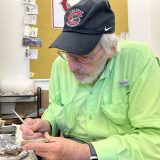Not so Vanilla: Could Genetically Modified Vanilla be the New Normal? by Leandra Filiaci. MS in Food Science student
November 15, 2016
With summer ending and the leaves changing color, the countdown to our cherished fall holidays begin. Halloween just ended and Thanksgiving Break is right around the corner; this mixture of holidays and cooler weather creates a more comfortable and relaxed ambiance–an ambiance of familiar fall flavors–from pies and turkeys, to baked goods and spice-flavored drinks. Individuals are moving from their summer diets to a time of home cooked holiday feasts and freshly baked desserts. One essential ingredient in many baking recipes, and an essential fall flavor, comes from the vanilla bean. The distinct botanical flavor of vanilla is infamous for evoking a mouthwatering response. Additionally, vanilla is an important element of many other familiar fall tastes as well. It balances sweetness and masks bitterness in other popular fall flavors including chocolate and caramel.
In the last five years or so, as well as the forecasted next few years, there has been a shortage of the natural source of this beloved flavor: the vanilla bean. You may have noticed this through the spike in the prices of pure vanilla extract or frozen desserts like ice creams dating back to 2010. To combat the issue of high costs, the food industry has come up with alternative sources of vanillin–the main component in vanilla responsible for the flavor we all know and love. In the 1800s and 1900s vanillin started to be synthesized from other sources, including pine bark, clove oil, rice bran, and lignin.
As you stroll down the aisles of the grocery store, you will see that there are two types of vanilla on the shelf, with one cheaper than the other. This price difference is simply due to their means of production and source. The more expensive being pure vanilla from the vanilla orchid, and the other being synthetic vanilla. In today’s market, pure vanilla accounts for only about 1% of the vanilla available while 85% of the vanilla flavor in the market is made from vanillin synthesized from the petrochemical precursor guaiacol.
With synthetic vanilla on the market, the food industry has managed to overcome the vanilla shortage. However, recent shifts in consumer demand towards all-natural ingredients have once again brought this shortage to light. For instance, General Mills, Hershey’s, Kellogg’s and Nestle have reformulated their products, vowing to use only pure vanilla in their products in order to meet consumer demands towards all-natural ingredients. This has caused great concerns in the industry as demand for pure vanilla is now much higher than the supply available. Companies are now not only facing the challenge of reformulating their products, but also dealing with the rising prices of pure vanilla and with the long talked about question of “what is natural?”.
As a solution to this, Evolva developed a way to feed glucose to genetically modified microbes that produce vanillin glucoside. Vanillin glucoside makes vanillin less toxic to the microbes used, though it still needs to be removed from the end-product to get vanillin, which many are now calling “synbio vanillin”. Evolva licensed its technology to IFF in 2014, however it is still yet to be seen on the market.
For companies that vow to use natural flavors but can’t afford the high prices of pure vanilla, this new synbio vanillin could be the solution. Due to the vague nature of the word natural in food labeling, this synbio vanillin made from GM yeast could count as natural since yeast fermentation is a natural process. Since the microbe that is GM is a processing aid, a product made by this process would also not fall under U.S. GMO labeling requirements. Additionally, because synbio vanillin is chemically identical to synthetic vanillin already in the market, it can be identified as a GRAS (generally recognized as safe) ingredient without going through any government evaluations because GRAS status in flavors is evaluated by the Flavor and Extract Manufactures Association (FEMA) instead.
Many however have seen this synbio vanillin as the villain. Groups like Friends of the Earth (FOE) have petitioned numerous food companies, like Haagen-Dazs, to vow not to use synbio vanillin. This group claims that synthetic vanillin is a risk to human health, the environment, and the economy. However, they have no basis on whether this is truly the case. Synthetic vanillin has been on the market since the late 19th century and there has been no indication that it is a health risk, this sybio vanillin would be essentially the same product. Additionally, FOE claims that this synbio vanilla will outcompete pure vanilla extract and therefore put farmers out of work by causing the vanilla farms to diminish. This however would not be the issue because synbio vanillin would be competing with synthetic vanillin, not pure vanilla. They would simply be a means for companies who can’t afford pure vanilla, and who use synthetic vanillin, to adopt a more natural alternative and able them to compete in today’s market.
As this genetic flavoring becomes more prominent however, research still needs to be conducted on not only to identify how consumers would react to these products, but also on the environmental consequences of this new procedure. Since yeast requires sugar for energy, studies must be done to see if this procedure would possibly be more sustainable than vanillin made from petrochemicals. For instance, if used for mass production, there could be large impacts on sugarcane plantations which are already responsible for the loss of many biodiversity hotspots. Ultimately, it is up to the consumer to decide–which product is consistent with the values they hold in regards to chemicals in food; vanillin made from petrochemicals or vanillin made by fermentation.
This article is part of our on-going series “The Science of Food” which is comprised of essays from students in the M.S. in Food Science program at Chapman University. The essay was originally published on the Food Science Student Association’s blog, which you can read here: http://chapmanfsnsa.blogspot.com/.


